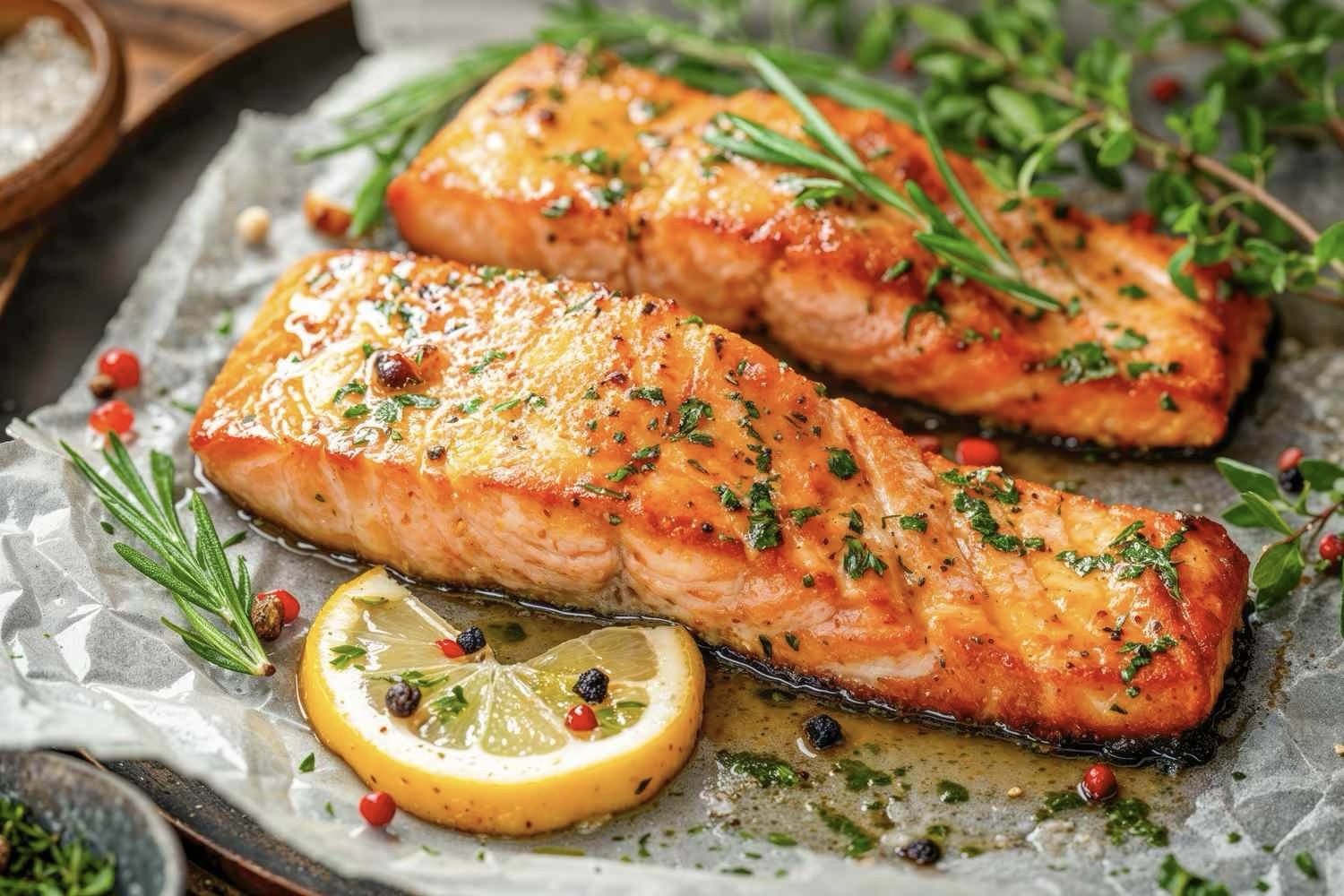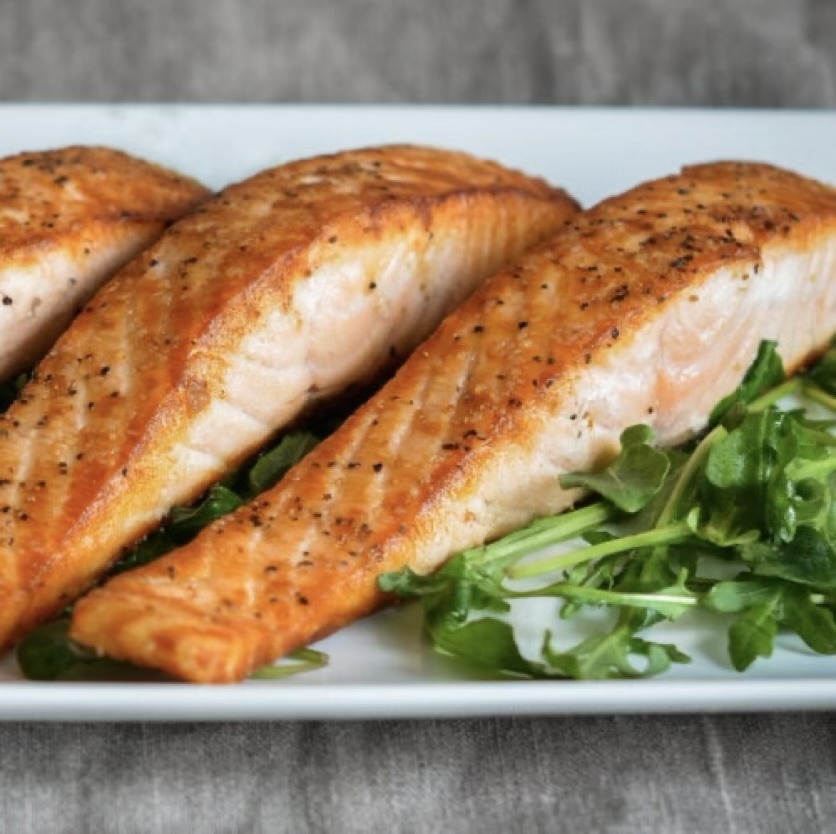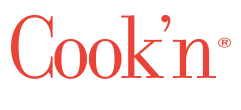Even with Concerns, It’s STILL on the “GOOD FOR YOU!” List
We’re trying to eat more salmon at our house and I’ve been exploring all sorts of ways to prepare it. How about you—do you have a favorite way of prepping it?

Well, I ran onto a recipe at www.allrecipes.com that is dynamite. So good in fact, that it’d be just wrong not to share it.
This is a super simple meal that is largely hands off (perfect for this time of year, wouldn’t you say?). The bright lemon pairs beautifully with the tender garlicky salmon on a bed of pasta. The recipe originator, Rebekah Rose Hills, suggests garnishing liberally with some Parmesan cheese when serving. See what you think:
Baked Lemon-Butter Salmon with Pasta

salt and freshly ground pepper to taste
1 8 ounce fillet of salmon
1 medium lemon halved and divided
1 tablespoon garlic minced
2 tablespoons butter cut into pieces, divided
4 ounces dry fettuccini pasta
1 tablespoon extra virgin olive oil
1/2 tablespoon dried parsley
1/4 teaspoon salt
1/8 teaspoon ground black pepper
Directions:
1. Preheat the oven to 390 degrees F (200 degrees C).
2. Lightly salt and pepper salmon fillet on both sides, and place in a 2-quart baking dish. Squeeze 1 lemon half over the salmon, then sprinkle with minced garlic and 1/2 of the butter pieces.
3. Bake in the preheated oven until salmon is cooked through and flakes easily with a fork, about 15 minutes.
4. Meanwhile, fill a large pot with lightly salted water and bring to a rolling boil. Cook fettuccine at a boil until tender yet firm to the bite, about 8 minutes.
5. When salmon is cooked, break apart into large chunks (it will break apart a little further when you toss it with the pasta.)
6. Add cooked pasta to the baking dish with the salmon. Drizzle pasta and salmon with olive oil, and add remaining butter pieces. Zest the remaining lemon half and add to the pasta, then squeeze juice from the zested lemon into the pasta as well. Add parsley, salt, and pepper.
7. Toss everything gently until pasta is well coated in the pan juices and everything you have added in, and salmon is evenly distributed amongst the pasta. Taste and adjust seasonings if necessary. Add a touch more butter or oil if needed, if your pasta is too dry.
2. Lightly salt and pepper salmon fillet on both sides, and place in a 2-quart baking dish. Squeeze 1 lemon half over the salmon, then sprinkle with minced garlic and 1/2 of the butter pieces.
3. Bake in the preheated oven until salmon is cooked through and flakes easily with a fork, about 15 minutes.
4. Meanwhile, fill a large pot with lightly salted water and bring to a rolling boil. Cook fettuccine at a boil until tender yet firm to the bite, about 8 minutes.
5. When salmon is cooked, break apart into large chunks (it will break apart a little further when you toss it with the pasta.)
6. Add cooked pasta to the baking dish with the salmon. Drizzle pasta and salmon with olive oil, and add remaining butter pieces. Zest the remaining lemon half and add to the pasta, then squeeze juice from the zested lemon into the pasta as well. Add parsley, salt, and pepper.
7. Toss everything gently until pasta is well coated in the pan juices and everything you have added in, and salmon is evenly distributed amongst the pasta. Taste and adjust seasonings if necessary. Add a touch more butter or oil if needed, if your pasta is too dry.
Recipe formatted with the Cook'n Recipe Software from DVO Enterprises.
Were you aware that there are 3 basic varieties of salmon? Coho is larger and has fewer spots. It has a green head and a maroon flank (body) when it's mature. Chinook tends to be brownish green with large peanut-shaped or 'W' spots. And Steelhead has pink cheeks and flanks and smaller spots on their bodies and tails.

There’s been considerable conversation over whether you should eat farmed or wild salmon. The first consideration is the difference in fat content. Three ounces of wild salmon has fewer calories and half of the amount of fat than that of farmed salmon. Farmed options also have more saturated fat. But wild salmon has less omega-3 fatty acids than farmed salmon.
Pollutant issues is another concern. PCB (polychlorinated biphenyl) is a type of persistent organic pollutant (POP). Research shows there's 16 times more of this POP in farmed fish compared to wild fish. This is important because POPs are linked to obesity, type 2 diabetes, and the risk of stroke in women.

And of course, there’s always worry over other contaminants. Experts say that there are usually more contaminants in farmed salmon than in wild salmon. The FDA considers the contaminant levels are safe (how could ANY contaminant be safe??), but the U.S. Environmental Protection Agency (EPA) disagrees.
All this said, studies conclude that children, women of child-bearing age, and pregnant women should opt for wild salmon instead of farmed fish. And it's best to take off the skin of all types of fish to avoid as many contaminants and pollutants as possible.
With the SALMON 101 tutorial out of the way, and considering the above-mentioned risks, WHY eat salmon at all? Because it’s an excellent source of vitamins D, B12 and B6, potassium, selenium, phosphorous, iodine, choline, pantothenic acid, biotin, and omega-3 fatty acids. In spite of the concerns, it’s still on the “GOOD FOR YOU!” list.
It’s a shame our food supply is becoming so polluted, but at least there’s some hope, what with the availability of wild salmon still an option!
 Alice Osborne
Alice Osborne
Weekly Newsletter Contributor since 2006
Email the author! alice@dvo.com
Sources:
- www.simplyrecipes.com
- www.allrecipes.com
- www.idahostatejournal.com
- www.organicconsumers.org
- www.onceuponachef.com
